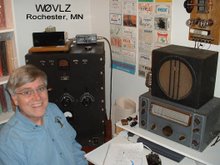I’ve started on a new transmitter for the next AWA Bruce Kelley
1929 QSO Party. The “BK” requires non-crystal-controlled transmitters that are
of 1920s design and use tube types that were available in 1929. I found a
transmitter described in the January 1934 issue of QST that meets these
requirements.
For a good over view of the transmitters built to be used in
the BK take a look at VE7SL’s gallery page at
https://qsl.net/ve7sl/29gallery.html
. Of the 65 transmitters 48 are either Hartleys or TNTs. The next one in
the
list was the TPTG with 9. Only 2
were Colpitts. I have TNT and Hartley transmitters for the BK and a TPTG is a lot
like a TNT so building a Colpitts for the BK sounds like a good next choice. This
will round out my 1920s “big three”.
The 1934 QST article lists several features of this design
that sound attractive:
Antenna coupling to
the non-plate portion of the tank coil. The more common link coupling to
the plate ends of the tank coil results in more second harmonic output and less
frequency stability when the antenna is tightly coupled for maximum output.
Center/swinging link coupling should be an improvement.
Push-pull tube capacitance
in series. Temperature changes within the tubes that impact the
interelectrode capacities will have less impact on frequency stability. This
configuration also reduces the amount of current through the tubes.
Symmetric layout.
A symmetric layout is less prone to exhibit signal instability
Grounded tuning capacitor
body. In this design the tank tuning capacitor body provides shielding so
that hand capacity has less of an impact on frequency. This transmitter should
be easier to get on frequency.
Easily converted to
an amplifier. If I decide to move on to a MOPA BK rig this will be one
section that I already have.
In addition to information about this particular transmitter
design, this QST article also gives hints that are useful for any 20s
transmitter:
Use a
well-regulated/stiff power supply
Route power and
antenna cables away from the transmitter
Do not place the power
supply close to the transmitter
Now, may the parts hunt begin!
 I'm making good progress on my new transmitter. With a lot of help from my friend KE0EXE and his table saw I now have a nice looking oak base. I went ahead and shellacked it so that it looks pretty good. 3/16" copper tubing for the antenna link and 80 meter coil was not available locally so I have to go to Amazon for that but I did find 1/4" tubing for the 40 mtr coil at my local big box hardware store. I added a National type A vernier dial to the Cardwell tuning capacitor. This should help a lot getting on frequency.
I'm making good progress on my new transmitter. With a lot of help from my friend KE0EXE and his table saw I now have a nice looking oak base. I went ahead and shellacked it so that it looks pretty good. 3/16" copper tubing for the antenna link and 80 meter coil was not available locally so I have to go to Amazon for that but I did find 1/4" tubing for the 40 mtr coil at my local big box hardware store. I added a National type A vernier dial to the Cardwell tuning capacitor. This should help a lot getting on frequency.



